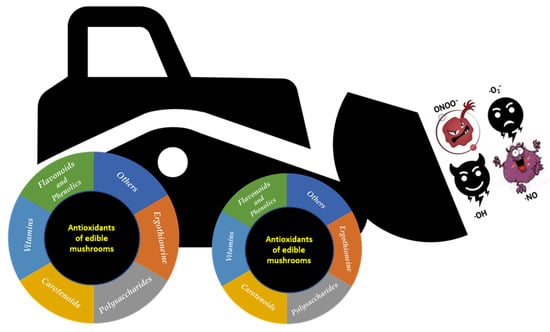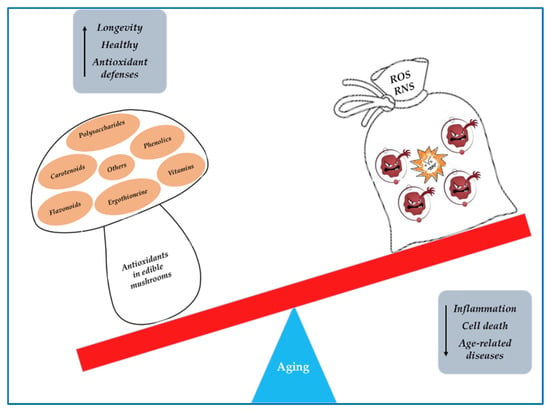Mushrooms have been used for their nutritional value and medicinal properties. They therefore represent not only a food but also a precious source of biologically active compounds that act as nutraceuticals. Numerous studies have shown that edible mushrooms possess anticancer, anti-atherosclerotic, hypocholesterolemic, hypolipidemic, antiviral, antimicrobial, immunostimulant, anti-inflammatory, antioxidant, and anti-aging effects. The antioxidant properties of edible mushrooms are mainly related to their content in phenolic compounds and polysaccharides. Among polyphenol groups, phenolic acids are the main antioxidants, whereas the major antioxidant effects of polysaccharides are attributed to beta-glycans. These compounds show significant reactive oxygen species (ROS) scavenging activity and are also able to stimulate the activity of superoxide dismutase (SOD), catalase (CAT), and glutathione peroxidase (GPx) enzymes.
1. Mushrooms as Sources of Antioxidant Compounds
Mushrooms belonging to the phylum
Basidiomycota include around 2000 edible/medicinal species, but only a few dozen of them are currently cultivated commercially in the world
[1][50]. Among the cultivated species, the most commercially important are
Agaricus bisporus (button),
Lentinula edodes (shiitake),
Boletus edulis (porcino),
Pleurotus eryngii (king oyster mushroom),
Pleurotus ostreatus (oyster mushroom),
Agrocybe aegerita (pioppino),
Flammulina velutipes (enoki),
Grifola frondosa (maitake),
Volvariella volvacea (paddy straw mushroom),
Calocybe indica (milky mushroom), and
Hericium erinaceus (lion’s mane mushroom)
[2][51]. The top five of the most cultivated mushrooms worldwide is composed by five genera:
Agaricus,
Lentinus,
Pleurotus,
Flammulina, and
Auricularia, accounting for 85% of the cultivated edible mushrooms. In the last decade, especially, humans consumed several mushroom species for health benefits, and thus improved the commercial cultivation demand and the global markets
[3][4][52,53]. Edible mushrooms, including those wild-harvested or cultivated fungal species, possess excellent organoleptic properties and high nutritional values. Their nutritional composition shows a wide variability among the different species
[5][54]. Mushrooms are a low calorie food (~28–35 kcal/100 g), rich in fibers and poor in fats, and, in addition, they are gluten- and cholesterol-free. The fruiting bodies contain around 85–90% water, whereas their dry matter have approximately 50–65% of total carbohydrates, 19–35% proteins, and 2–6% fat. Mushrooms are a good source of unsaturated fatty acids, vitamins (B1, B2, B12, C, D), and high-quality proteins as they contain all the essential amino acids. The minerals found in mushrooms are principally potassium, phosphorus, calcium, iron, manganese, magnesium, zinc, and selenium
[6][55]. In addition to their culinary properties, mushrooms are a precious source of biologically active compounds that act as nutraceuticals. In fact, they have a low lipid content and a high content of proteins, fibres, unsaturated fatty acids, glucans, vitamins, phenolic compounds, minerals, and secondary metabolites
[2][7][8][9][51,56,57,58]. Numerous studies have shown that edible mushrooms possess anticancer, antiatherosclerotic, hypocholesterolemic, hypolipidemic, antiviral, antimicrobial, immunostimulant, anti-inflammatory, antioxidant, fibrinolytic, and anti-aging properties
[10][11][12][13][14][15][16][17][18][11,59,60,61,62,63,64,65,66]. Furthermore, edible and medicinal mushrooms contain several mycochemicals with antioxidant activity, such as phenols, flavonoids, polysaccharides, vitamins, carotenoids, ergothioneine, and others
[8][19][20][21][57,67,68,69] (
Figure 1).
Figure 1. The antioxidant mycochemicals of edible and medicinal mushrooms.
The antioxidant mycochemicals of edible and medicinal mushrooms.
2. Oxidative stress in aging and age-related neurodegenerative diseases
Oxidative stress has been identified as a major risk factor associated with aging and the initiation and progression of age-related neurodegenerative disorders, such as Alzheimer's (AD) and Parkinson's (PD) diseases [5]. Currently, AD and PD, affecting millions of people worldwide, represent the most prevalent age-related neurodegenerative disorders constituting a major health problem for aging societies.
Alzheimer’s Disease
Alzheimer’s disease is the main cause of dementia. It is characterized by a severe atrophy of the cerebral cortex caused by neuron death and synaptic degeneration, and it is manifested by psychological, motor, and memory impairment
[22][18]. Hallmarks of AD are extracellular amyloid plaques formed by an aggregation of amyloid-beta peptide (Aβ) and the presence of intracellular tau neurofibrillary tangles (NFT) and neuroinflammation
[23][24][19,20]. Oxidative stress represents a key player in the pathogenesis of AD
[25][21], since it contributes to Aβ production and plaque apposition, but, at the same time, extracellular Aβ accumulation and impaired mitochondrial function could trigger free radical formation
[26][22]. Increased ROS levels also contribute to the hyperphosphorylation of Tau, to the formation of neurofibrillary tangles and to cell death
[27][5]. Another mechanism by which oxidative stress influences AD could be the imbalance of bioactive metals
[28][23]. In fact, the post-mortem analysis of brains of AD patients showed an accumulation of iron, zinc, and copper in Aβ plaques, and the ability of these metals to promote Aβ aggregation
[29][24] and Tau hyperphosphorylation
[30][25]. Finally, amyloid, Tau protein, and ROS affect the activity and uptake of the glutamate receptor by exacerbating Ca
2+ influx into postsynaptic neurons, thus leading to an oxidative condition that ultimately determines the synaptic dysfunction responsible for AD
[31][32][26,27].
Parkinson’s Disease
Parkinson’s disease is the second most common neurodegenerative disorder resulting from progressive degeneration of the dopaminergic neurons in the substantia nigra (SN) pars compacta associated with microglia activation. The main pathological hallmarks of PD are intracellular inclusions that contain aggregates of α-synuclein (α-Syn) (Lewy bodies). The motor symptoms of PD in patients include weakness, tremor, rigidity, bradykinesia, and postural instability
[33][34][36,37]. In PD, the oxidative stress is associated with the aggregation of the presynaptic protein α-Syn and the formation of Lewy bodies. Elevated levels of oxidative and nitrosative stress markers such as 4-HNE, carbonyl protein, 8-hydroxy-2′-deoxyguanosine (OH8dG), and 8-hydroxyguanosine were detected in serum, cerebrospinal fluid, and postmortem specimens of the brains of patients suffering from PD.
[35][36][37][38][38,39,40,41]. Similarly, α-sin nitration levels were increased in the brain of PD patients
[39][42]. The role of oxidative stress in the sequence of events leading to the degeneration of dopaminergic neurons is also due to the apoptosis of dopaminergic brain cells triggered by activation of the p38 mitogen-activated protein kinase pathway
[40][43]. In addition, elevated levels of lipid peroxidation markers have been detected in the post-mortem brains of PD patients
[41][44]. High levels of MDA linked to α-synuclein have been evidenced in the frontal cortex of PD cases, supporting the hypothesis that lipid peroxidation may precede and contribute to α-Syn aggregation
[42][45]. Glycated protein levels were also significantly higher in the cerebral cortex of PD patients than in the controls
[43][46].
3. Antioxidant Compounds of Mushrooms as Neuroprotective Agents
It has been reported that mushroom antioxidant compounds, due to their ability of increasing antioxidant defenses and counteract oxidative stress, may prevent age-related neurological diseases
[44][45][46][47][165,166,167,168] (
Figure 2).
Figure 2.
The supplementation of mushroom antioxidants to counteract the ROS/RNS in aging.
Cheng et al.
[48][192] showed that polysaccharides purified by the mushroom
Hericium erinaceus exerted protective effects on Aβ-induced neurotoxicity in PC12 cells through radical scavenging activity, and also reduced ROS production and recovery of mitochondrial function. In another study conducted on glutamate damaged PC12 cells, Zhang et al.
[49][193] demonstrated that the neuroprotective effect of
H. erinaceus was associated with the protection of mitochondrial dysfunction and the subsequent suppression of ROS accumulation. Furthermore, the same authors using a mouse model of AD observed an increase in the concentrations of acetylcholine (Ach) and choline acetyltransferase (ChAT) in the serum and hypothalamus of mice treated with
H. erinaceus. Recently, it has been demonstrated that extracts from
H. erinaceus possess anti-inflammatory and antioxidant action. Indeed, the extracts were able to counteract neurotoxicity induced by hydrogen peroxide in HT22 mouse hippocampal neurons by decreasing ROS production and increasing the activity of the antioxidant enzymes CAT and GPx, and by reducing nitric oxide (NO) levels in LPS-treated BV2 microglia
[50][194]. An et al.
[51][195] demonstrated in an AD mouse model that the administration of polysaccharides derived from
Armillaria mellea enhanced serum and hypothalamic levels of SOD and GPx and counteracted ROS production. These events were accompanied by an improvement of cholinergic system functions as indicated by the enhancement of Ach and choline ChAT concentration, and by a decrease in acetylcholine esterase (AchE) levels in the serum and hypothalamus. In addition, it was demonstrated that
Armillaria mellea polysaccharides reduced the deposition of Aβ and attenuated the oxidative damage and p-Tau aggregation in the hippocampus. In a similar study, Zhang et al.
[52][188] showed that the extract of
Pleurotus ostreatus attenuated learning and memory impairment in an AD rat model elevating SOD, GPx, and CAT activities, and reducing malondialdehyde (MDA) levels and AchE activity. In addition, this extract decreased amyloid peptide formation and Tau phosphorylation by increasing the expression of protein phosphatase 2A and reducing the expression of amyloid precursor protein (APP). The beneficial neurological effects exerted by polysaccharides are not only expressed in pathological conditions but also in the physiological events that characterize aging. In this respect, Chen et al.
[53][181], using a natural aging rat model, demonstrated that polysaccharides from
Grifola frondosa improved learning and memory. These improvements were related to the antioxidant properties of
G. frondosa, as evidenced by the increase in the activity of antioxidant enzymes and total antioxidant capacity, and by the decrease in NO and MDA levels in old rat brain. The neuroprotective and anti-age potential of polysaccharides from
G. frondosa has been also tested in the yeast cells and
Drosophila melanogaster models of PD, showing the ability to reduce both ROS levels and the toxicity of synuclein
[54][196].


